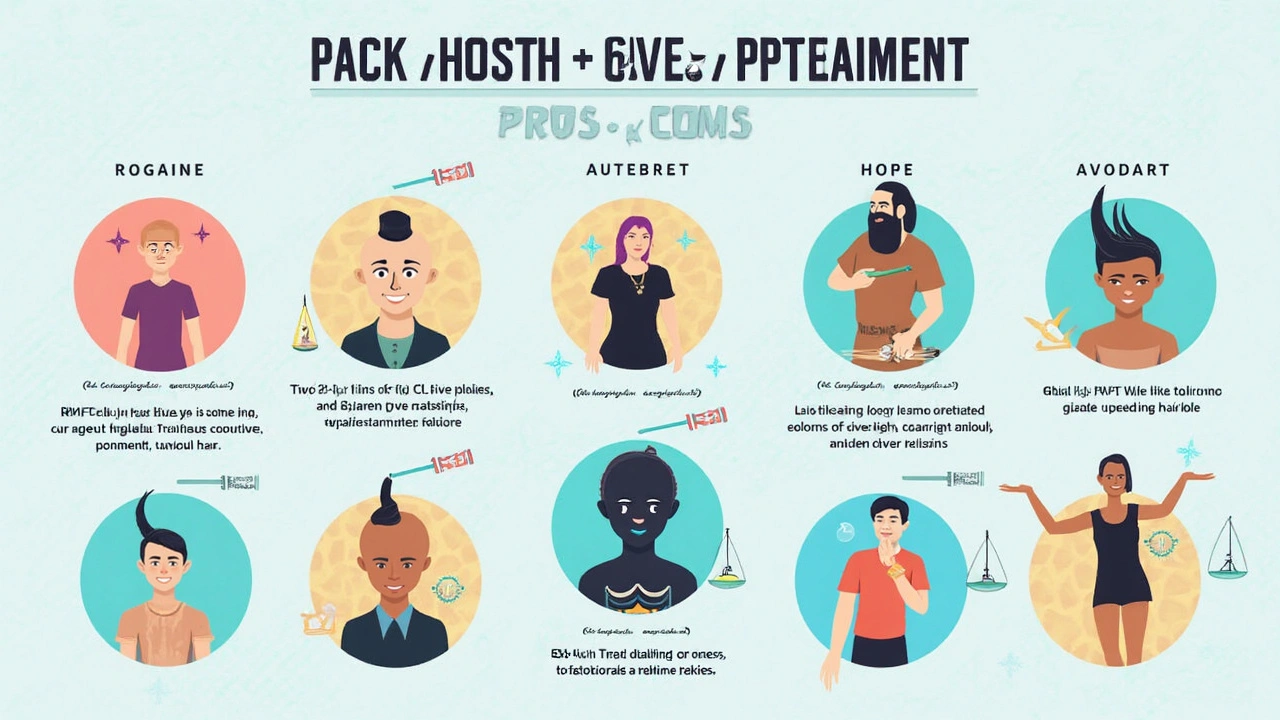Top 6 Alternatives to Propecia: What You Need to Know

If you’re dealing with hair loss and Propecia isn’t cutting it for you, don’t worry—there are other options out there. Let’s discuss six alternatives to Propecia that might just do the trick. From topical solutions to light therapy, these options cover various approaches to managing hair loss. Exploring each alternative will help you figure out what suits your lifestyle and needs best.
- Rogaine (Minoxidil)
- Avodart (Dutasteride)
- Ketoconazole Topical
- Low-Level Laser Therapy (LLLT)
- Saw Palmetto
- Spironolactone
- Conclusion
Rogaine (Minoxidil)
When it comes to tackling hair loss, Rogaine, which contains minoxidil, is a popular choice. It's an FDA-approved topical solution that you apply directly to the scalp. Unlike Propecia, which is ingested and can have systemic effects, Rogaine works at the surface level. It’s available over-the-counter, so no prescription is needed.
How does it work? Essentially, minoxidil stimulates hair follicles by widening blood vessels, improving blood flow to the hair roots, which can help hair regrow in places where it’s thinning. Plus, continuous application helps maintain the growth. But, you need to use it consistently—results can take 3 to 6 months to appear and stopping treatment will usually result in a reversal of hair growth.
Pros
- No prescription needed.
- Minimal systemic side effects.
- Proven to promote hair regrowth with consistent use.
Cons
- Needs to be applied twice daily for best results.
- Can cause dry, itchy scalp for some users.
- Results can vary; not everyone experiences significant regrowth.
Avodart (Dutasteride)
When considering alternatives to Propecia for hair loss treatment, Avodart (Dutasteride) often comes up. Dutasteride is primarily used for treating benign prostatic hyperplasia (BPH), but its ability to block the conversion of testosterone to dihydrotestosterone (DHT) makes it a potential option for addressing hair loss, too.
Dutasteride blocks both types of 5-alpha-reductase enzymes—type 1 and type 2. This dual action is why some people believe it's more effective than finasteride at reducing DHT levels. The more significant reduction in DHT might provide better results for certain individuals struggling with hair loss, although it's crucial to note that Avodart is not FDA-approved for this use, making it an off-label treatment.
Pros
- Might be more effective at reducing DHT levels than finasteride.
- Possibly better results for some individuals struggling with hair loss.
Cons
- Not FDA-approved for hair loss treatment, meaning it's an off-label use.
- Shares similar side effects with finasteride, including potential sexual side effects.
- May affect prostate-specific antigen (PSA) testing results, complicating prostate health monitoring.
With its potential for greater potency in reducing DHT, some people gravitate towards Avodart (Dutasteride) despite its off-label status. If you're considering this option, it's essential to consult with a healthcare provider to understand the risks and benefits specific to your health situation.
Ketoconazole Topical
When it comes to hair loss treatments, Ketoconazole Topical might sound unusual at first, but it has some interesting benefits. Originally designed to treat fungal infections, it turns out it’s also pretty handy for helping with hair loss, especially when it comes to those pesky dandruff-related issues.
The active ingredient, ketoconazole, helps reduce inflammation and any microbial activity on the scalp. In simpler terms, it keeps things clean and healthy up there, which is crucial if you’re looking to keep as much hair as possible.
Pros
- Multi-beneficial: Besides combating hair loss, it also handles dandruff and scalp itching.
- Easy to use: Simply replace your regular shampoo a couple of times a week.
- Minimal side effects: Compared to other systemic treatments, this topical solution usually doesn't have bad side effects.
Cons
- Limited effectiveness: On its own, it might not be as effective as some other stronger treatments out there.
- Requires consistent use: You'll need to keep using it over time to see any lasting results.
While not a standalone miracle cure, combining Ketoconazole Topical with other treatments like Minoxidil could amplify the benefits, making it a great part of a broader hair care strategy.
| Frequency | Use |
|---|---|
| 2-3 times a week | Replace regular shampoo |

Low-Level Laser Therapy (LLLT)
You might not have heard much about Low-Level Laser Therapy (LLLT), but it’s gaining some popularity as a hair loss treatment option. It involves using lasers to stimulate hair growth. Sounds high-tech, right? It’s pretty straightforward when you break it down.
LLLT uses low-level lasers or light-emitting diodes (LEDs) to expose scalp tissues to photons. These photons are absorbed by weaker cells to encourage hair follicle growth. Think of it like giving your hair a little pep talk, waking it up, and getting it back to growing.
- Offered as either in-clinic treatments or take-home devices like laser combs or caps.
- Considered non-invasive, painless, and without major side effects.
Research is still ongoing, but some studies suggest potential benefits for hair density and thickness. Keep in mind, results can vary widely, and consistency is key when using at-home devices.
Before diving into laser therapy, it's good to chat with a healthcare provider, especially to rule out any underlying conditions that could be affecting your hair health. Remember, while LLLT might be helpful, it’s not a one-size-fits-all solution.
Saw Palmetto
Saw Palmetto is a popular natural supplement people often consider as an alternative to Propecia for hair loss. Derived from the fruit of the Serenoa repens tree, this supplement is believed to help balance hormone levels, specifically dihydrotestosterone (DHT), which plays a key role in hair loss.
Although there's some buzz around it potentially reducing hair loss, the clinical evidence is still somewhat limited. Some studies suggest that it might block DHT production similarly to what finasteride (found in Propecia) does, but the results aren't as conclusive.
Pros
- Natural option for those hesitant about prescription drugs
- Generally well-tolerated with minimal side effects
- May offer some benefit in reducing DHT levels
Cons
- Lacks robust scientific evidence compared to prescription alternatives
- Not regulated by the FDA for hair loss treatment
- Results can vary significantly from person to person
While Saw Palmetto is not the most proven option, it's an accessible and natural route that has found its way into many discussions about hair loss treatment alternatives. Just keep in mind, before jumping in, it’s always wise to chat with a healthcare provider, especially if you're considering combining it with other treatments.
Spironolactone
Spironolactone is primarily used as a diuretic, but did you know it doubles up as a rescuing knight for those grappling with hair loss? Originally designed to treat hypertension and excess fluid retention, it has found a place in the world of dermatology, helping manage androgenetic alopecia, especially in women. Though not as mainstream as other Propecia alternatives, it’s worth considering if you’re open to trying something off-label.
As an anti-androgen, spironolactone works by blocking androgen receptors, reducing the levels of male hormones, like testosterone, that can contribute to hair thinning. This is why it tends to be more effective in women, as men relying on these hormones might not see the same benefits and could risk feminizing effects.
Pros
- It tackles both acne and hair loss when these issues are hormone-related.
- A lower dose is often sufficient for hair loss, minimizing risks of side effects.
- Unlike some hair loss treatments, it can help regulate oily skin and reduce breakouts.
Cons
- Using it for hair loss is not FDA-approved; it’s an off-label treatment.
- It can have feminizing effects in men, which might not be desirable.
- There are potential side effects, including electrolyte imbalances and fatigue.
If you’re considering spironolactone, it’s a good idea to have a conversation with your doctor to weigh the benefits and see if it could fit your hair loss plan. It’s always best to approach with a health-first mindset, especially since this isn’t a one-size-fits-all situation.

Conclusion
Choosing the right hair loss treatment can be overwhelming, but exploring different Propecia alternatives gives you a variety of paths to consider. From topical solutions like Rogaine and Ketoconazole to advanced options like Low-Level Laser Therapy (LLLT), there's likely a fit for everyone depending on your specific needs and comfort levels.
A reputable source from the American Academy of Dermatology states,
"It’s important to address hair loss early to maintain existing hair. Consulting with a healthcare provider about alternative treatments can tailor a solution that best works for your situation."
Here's a quick comparison to sum it up:
| Alternative | Method | Pros | Cons |
|---|---|---|---|
| Rogaine (Minoxidil) | Topical | OTC, Easy application | Needs consistent use |
| Avodart (Dutasteride) | Oral | Effective for some | Off-label use |
| Ketoconazole | Topical | Aids scalp health | May cause irritation |
| LLLT | Laser Device | Non-invasive | Expensive |
| Saw Palmetto | Supplement | Natural option | Evidence lacks |
| Spironolactone | Oral | Balances hormones | Not suitable for everyone |
Remember, it's crucial to weigh the pros and cons, maybe even try some under professional supervision, to find which hair loss treatment works best for you. Always keep your healthcare vendor in the loop to ensure you're making the best choice for your health and lifestyle.

Christian Mutti
March 29, 2025 AT 20:07Okay but have y’all seen the side effects of Dutasteride? 😱 I’m not saying don’t try it-but my cousin went from ‘dude who shaves once a week’ to ‘emotionally unavailable robot’ in 3 months. Propecia was bad, but this? This is like trading a mosquito bite for a rattlesnake. 🐍
Liliana Lawrence
March 30, 2025 AT 01:02Can we just talk about how ketoconazole shampoo is the unsung hero of hair loss?!!?? I used to have dandruff so bad it looked like snowfall on my shoulders-now, I use Nizoral twice a week, and my scalp feels like a spa day every time. Plus, my hair’s thicker! Not a miracle? Maybe. But it’s the only thing that didn’t make me feel like I was injecting chemicals into my skull. 💆♀️✨
Sharmita Datta
March 31, 2025 AT 15:42Have you ever wondered if all these treatments are just a distraction? The real cause of hair loss is electromagnetic pollution from 5G towers, combined with glyphosate in our food supply-big pharma doesn't want you to know this because they profit from your desperation. Saw palmetto? It works, but only if you source it from organic Himalayan trees harvested under a full moon. Otherwise, it's placebo. I've studied this for 17 years. Trust me. 🌙📡
mona gabriel
April 2, 2025 AT 03:54LLLT is weirdly underused. I got a laser cap on sale last Black Friday, used it three times a week for six months-didn’t grow a full head back, but the thinning on my crown? Gone. Not magic. Not instant. But real. And no pills. No prescriptions. No weird dreams about losing my beard. Just light. Weird, right? But it worked. Maybe we’re overcomplicating this whole thing.
Also, spironolactone? Don’t try it unless you’re a woman or you’re okay with developing boobs. No joke. My brother tried it. Now he cries during rom-coms. Not worth it.
Phillip Gerringer
April 3, 2025 AT 03:36Let’s be clear: if you’re considering saw palmetto as a viable alternative to FDA-approved pharmaceuticals, you’re not just misinformed-you’re engaging in dangerous pseudoscience. The clinical evidence is statistically insignificant, and the lack of standardization in supplement manufacturing renders any purported efficacy meaningless. You’re not ‘going natural’-you’re gambling with your follicles. Minoxidil and LLLT have peer-reviewed data. Everything else is folk medicine wrapped in marketing. Stop wasting your time and your money.